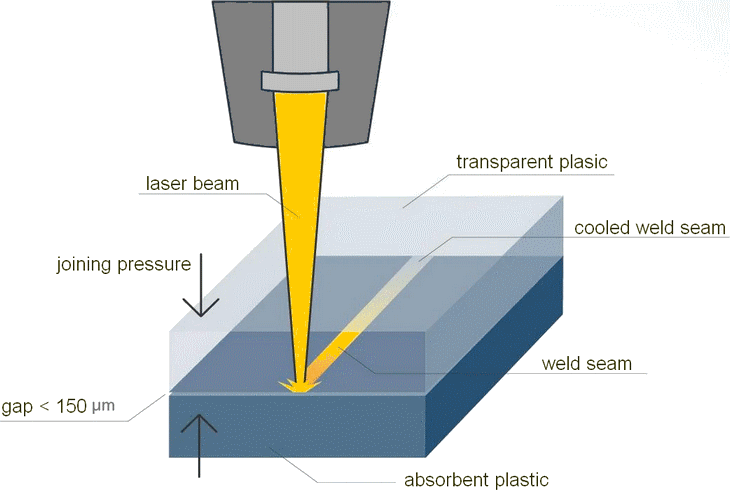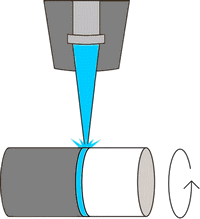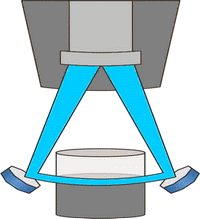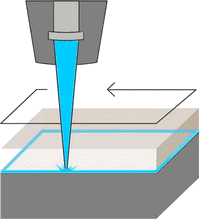Laser Welding of Plastics
In laser beam transmission welding, a part transparent to the laser and a laser-absorbing part are always joined together. Before welding, the joining partners are positioned and then pressed together.

The parts lying against each other should be pressed together using a suitable clamp to ensure sufficient heat transfer. As far as possible, the gap here should be smaller than 150 µm. For a permanent joint, the molten plastic must solidify completely. The clamping device therefore continues to press the two pairs together for a certain time after the actual welding process.
In the actual fusion process, the laser beam passes through the transparent component without significantly heating it, before the absorbing component absorbs the laser energy, heating the surface. This energy is transferred to the surface of the transparent component via thermal conduction.
The absorbed energy plasticises the plastic which, with pressure and heat conduction, bonds the components together. The existing joining pressure results in a substance-to-substance bond for both components. The hardness of the resulting weld is usually within the range of the strength of the base material.
Three laser transmission welding processes compared
Contour welding - Contour welding involves rotating round parts in particular up to 25 m/min under a laser beam. The contour to be welded is moved along it and heated up by the laser beam. Besides round parts, large three-dimensional components are also ideal for contour welding. The main problem with this process is that stresses can occur in very bulky parts because the contour of the part to be welded is not heated at the same time.

Simultaneous welding - In simultaneous welding, the laser beam is shaped to optimally adapt to the part. In this way, the contour to be welded is heated simultaneously. The result is very short process times of only about 100 ms. Low-complexity parts produced in large quantities are particularly suitable for this process. However, if the geometry of the part changes, the shape of the welding beam must also be adjusted.

Quasi-simultaneous welding - In quasi-simultaneous welding, a scanning laser beam heats the welding contour. As the laser beam rotates at up to 15 m/s (900 m/min), it works so fast that the contour is heated almost simultaneously before it has a chance to cool down. The programmable focusing optics allow quick reaction to changing welding contours - this is a clear advantage compared to simultaneous welding.

Like any other process, laser welding of polymers requires specific conditions to be successful. There are the following key factors:
Choice of suitable polymers, additives and pigments.
Use of the right laser source with suitable optics.
Correct joint configuration and small gap width.
Optimised clamping technique, allowing free access of the laser beam to the seam and applying sufficient pressure to the components.
References.. treffert.eu | www.trumpf.com
Related Post(s)

The use of lasers is a relatively new way of welding. Although the concept is still the same - using heat to join two materials - the way heat is delivered by lasers is quite unique...